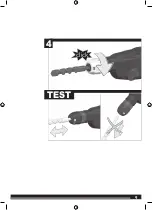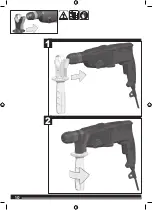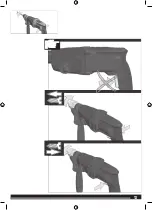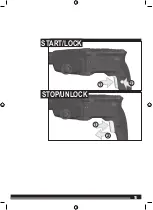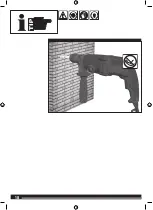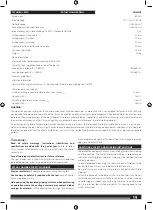
20
20
The possible causes may be:
●
it is tilted in the workpiece to be machined
●
it has pierced through the material to be machined
●
the power tool is overloaded
Do not reach into the machine while it is running.
The insertion tool may become hot during use.
WARNING!
Danger of burns
• when changing tools
• when setting the device down
Chips and splinters must not be removed while the machine is
running.
Keep mains lead clear from working range of the machine. Always
lead the cable away behind you.
When working in walls ceiling, or fl oor, take care to avoid electric
cables and gas or waterpipes.
Clamp your workpiece with a clamping device. Unclamped workpieces
can cause severe injury and damage.
Always disconnect the plug from the socket before carrying out any
work on the machine.
When working with large drill diameters, the auxiliary handle must
be fastened in a right angle with the main handle (see illustrations,
section “Twisting the handle”).
SPECIFIED CONDITIONS OF USE
The rotary pneumatic hammer can be used for hammer drilling,
chiselling in stone and concrete and drilling in wood, metal as well
as plastic.
Do not use this product in any other way as stated for normal use.
RESIDUAL RISKS
Even when the rotary hammer drill is used as prescribed, it is still
impossible to completely eliminate certain residual risk factors. The
following hazards may arise and the operator should pay special
attention to avoid the following:
■
Risk of electrocution if electric cables are drilled into. Always
grasp the tool by designated handles, do not touch the drill bits.
■
Kick-back whilst drilling if the bit jams. Always use the side handle
and grip the tool firmly.
■
Damage to the respiratory system. Wear respiratory protection
masks containing filters appropriate to the materials being
worked. Ensure adequate workplace ventilation. Do not eat, drink
or smoke in the work area.
■
Damage to hearing. Always wear effective hearing protection and
limit exposure to noise.
■
Damage to eyes from flying dust and debris particles. Always
wear suitable eye protection.
■
Injury caused by vibration. Hold the tool by designated handles
and limit exposure to vibration. See “RISK REDUCTION”.
RISK REDUCTION
It has been reported that vibrations from hand-held tools may
contribute to a condition called Raynaud’s Syndrome in certain
individuals. Symptoms may include tingling, numbness and blanching
of the fingers, usually apparent upon exposure to cold. Hereditary
factors, exposure to cold and dampness, diet, smoking and work
practices are all thought to contribute to the development of these
symptoms. There are measures that can be taken by the operator to
possibly reduce the effects of vibration:
■
Keep your body warm in cold weather. When operating the unit
wear gloves to keep the hands and wrists warm. It is reported
that cold weather is a major factor contributing to Raynaud’s
Syndrome.
■
After each period of operation, exercise to increase blood
circulation.
■
Take frequent work breaks. Limit the amount of exposure per day.
If you experience any of the symptoms of this condition, immediately
discontinue use and see your doctor about these symptoms.
WARNING!
Injuries may be caused, or aggravated, by prolonged use
of a tool. When using any tool for prolonged periods, ensure you take
regular breaks.
MAINS CONNECTION
Appliances used at many different locations including wet room and
open air must be connected via a residual current device (FI, RCD,
PRCD) of 30 mA or less.
Connect only to single-phase AC current and only to the system
voltage indicated on the rating plate. It is also possible to connect to
sockets without an earthing contact as the design conforms to safety
class II.
Make sure the product is switched off before plugging in.
This is a device for professional use which may slightly exceed the
guide values for current harmonics when it is connected to the public
low voltage mains supply. You should therefore contact your energy
supply company before you connect the device to the public low
voltage mains supply.
MAINTENANCE
The ventilation slots of the product must be kept clear at all times.
Important note! If the carbon brushes are worn, in addition to
exchanging the brushes the tool should be sent to after-sales service.
This will ensure long service life and top performance.
If the supply cord of the product is damaged, it must be replaced
by a specially prepared supply cord available through the service
organisation.
Use only AEG accessories and spare parts. Should components need
to be replaced which have not been described, please contact one of
our AEG service agents (see our list of guarantee/service addresses).
If needed, an exploded view of the tool can be ordered. Please state
the Article No. as well as the product type printed on the label and
order the drawing at your local service agents or directly at:
Techtronic Industries Australia Pty Ltd
PO Box 1065
Mount Waverley VIC 3149
Tel. no. 1300 234 797
Australia
Techtronic Industries N.Z. Limited
PO Box 12-806
Penrose AUCKLAND 1642
Tel. no. 0800 234 797
New Zealand
Summary of Contents for KH24IXE
Page 1: ...KH24IXE Original instructions ...
Page 4: ...4 4 ...
Page 5: ...5 5 ...
Page 6: ...6 6 ...
Page 7: ...7 7 ...
Page 8: ...8 8 414 8 1 3 2 414 808 KH24IXE indd 8 07 06 2016 17 13 21 ...
Page 9: ...9 9 9 4 TEST click 414 808 KH24IXE indd 9 07 06 2016 17 13 21 13 21 ...
Page 10: ...10 10 414 10 1 2 414 808 KH24IXE indd 10 07 06 2016 17 13 21 ...
Page 11: ...11 11 11 1 2 3 414 808 KH24IXE indd 11 07 06 2016 17 13 21 13 21 ...
Page 12: ...12 12 ...
Page 13: ...13 13 ...
Page 14: ...14 14 414 ...
Page 15: ...15 15 15 START LOCK 2 2 1 1 STOP UNLOCK 414 808 KH24IXE indd 15 07 06 2016 17 13 22 ...
Page 16: ...16 16 1 1 2 2 414 16 1 1 2 2 414 808 KH24IXE indd 16 07 06 2016 17 13 22 ...
Page 17: ...17 17 17 1 1 2 2 1 2 414 808 KH24IXE indd 17 07 06 2016 17 13 22 13 22 ...
Page 18: ...18 18 18 414 808 KH24IXE indd 18 07 06 2016 17 13 22 ...
Page 22: ...22 22 ...
Page 23: ...23 23 ...




